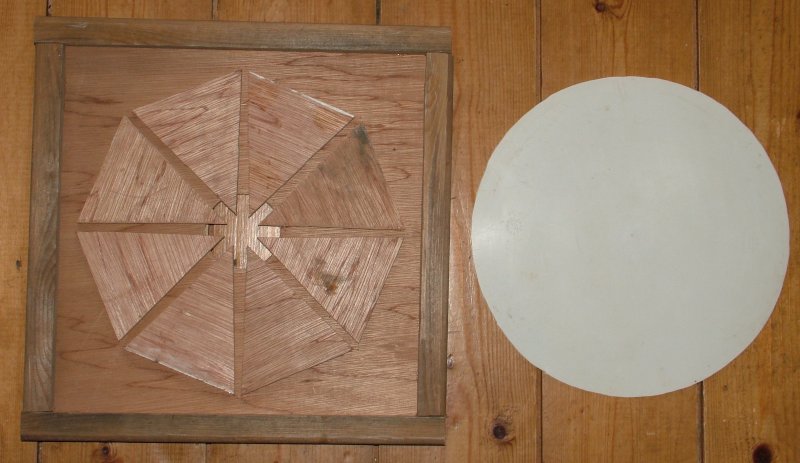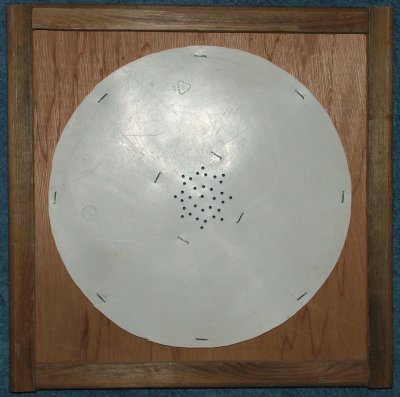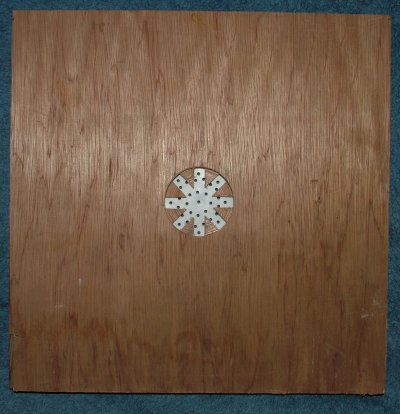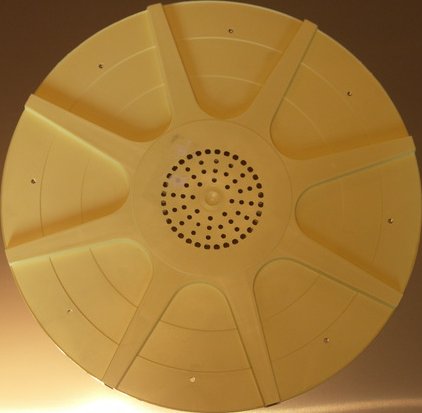
8-way clearer board for Warré hives
The board is made from 6 mm plywood and about 20 mm wide battens that are at least 12 mm thick to give a bee space below the clearer board when installed. Cut a board to fit your hive. Cut an approximately 60 mm diameter hole in its centre. Cut the battens to length to fit round the rim of the board.
Make a paper template with a 280 mm diameter circle drawn on it. Divide the circumference into eight equal parts. Prick through the marks on the circumference onto the board. These marks are for positioning the beeway separators.
Cut a strip of plywood exactly 115 mm wide and a minimum of 450 mm long. Mark on it eight isoceles triangles, abutting one another, with bases 100 mm and heights 115 mm. Saw up the eight triangles out (9 cuts). Use a saw with as small a kerf as possible. If in doubt, allow for the kerf in marking out the strip of plywood.
Glue the battens to the rim of the board. Following the layout shown below, glue the triangles to the board using the points marked on it as a guide such that the adjacent corners of the bases of a pair of triangles are 7 mm plus a kerf apart. The beeways will be about 12 mm wide at the hole in the board.

Cut a disc of so-called food grade plastic 280 mm in diameter, for example from the lid of a confectionary products bucket. Fix this disc over the beeways with staples or frame (gimp) pins. Drill a number of holes in the disc to provide ventilation for the boxes above and communication between the bees on both sides of the escape.
 Bottom view
Bottom view
 Top
view
Top
view
Use
Lightly smoke down between the combs of the boxes to be harvested. The main purpose of this is, together with the light introduced, to drive the queen down. Check that the boxes to be harvested are free of brood by turning them on edge with the combs in a vertical plane and examining between the bottoms of the combs. Place the clearer board on the hive below the boxes to be harvested. Leave for 2-4 hours. If the bees do not leave the boxes above the clearer board, it is likely that the queen is there or a significant patch of brood has been overlooked.
To save having to cut the triangles and the disc a plastic 8-way escape is available from some beekeeping equipment suppliers. A 6-way escape would suffice.

For example: http://www.materiel-apiculture.fr/apishop/70-chasse-abeille-8-sorties.html
This escape is reputed to work better than most. Other
commercial bee escapes with good reputations such as the Nicot Rhombus / Le Losange or the
'Canadian Double Triangle' do not fit the Warré hive. One can build the excellent vortex
bee escape or a 'Canadian Double Triangle' to fit a Warré hive, but some beekeepers may
wish to purchase their escapes. Roger Patterson, who manages the David Cushman website,
provided these sources for the 8-way bee escape:
http://beekeeping-equipment.co.uk/?s=sklep&id_prod=79
http://www.beehivesupplies.com/index.php?main_page=product_info&cPath=12&products_id=141
http://beekeeping.en.alibaba.com/product/355650051-210568929/beekeeping_equipment_8_way_bee_escape.html
David Cushman wrote: "It is circular, 258 mm in diameter. The volume of space that it
encloses is an eight pointed star. Each outlet nozzle is 7 mm wide by 6 mm tall. The
'points' of the star are 70 mm long and taper from 12.5 mm, the central body of the star
has 32 holes 3 mm in dia."
NOTES:
Vortex bee escape:
http://www.dave-cushman.net/bee/vortexescape.html
Canadian type bee escapes:
http://www.dave-cushman.net/bee/canadian.html